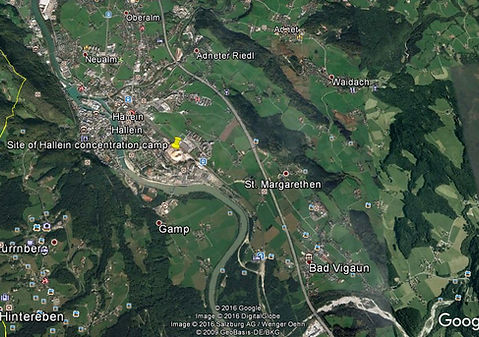
Forgotten Horrors
The Nazi sub-camp system
Hallein


Hallein was originally established as a base for mountain troops, the Mountain Troops Training and Replacement Battalion (Gebirgsjager Ausbiklungs Ersatzbataillon) No 6, which also accommodated wounded soldiers. From June 1943, or at least certainly from September of that year, around 30 males prisoners were brought to the site from Dachau. They were accommodated in wooden barracks in the quarry and were employed by the Bauleitung der Waffen SS und Polizei (Waffen SS and Police Building Administration).
The number of prisoners was subsequently increased to 90 persons. The camp was enclosed by wire and towers and a second barracks was built for the SS guards.
The prisoners constructed a shooting range and area for close quarter battle training. However, in the main, they were used for forced labour in the quarry and in the town and on surrounding farms. Dificult working conditions and poor food made more of the prisoners incapable of work, and this, according to prisoner Josef Plieseis, led to repeated random murders of prisoners by the guards. Plieseis himself managed to escape in 1943 with the help of a local woman, Agnes Primocic. This was one of three successful escapes from the camp. After his escape, Plieseis helped to lead a band of partisans in Salzkammergut.
In April 1945 there were still 55 prisoners remaining in the camp, but they were no longer required to work. Finally, thanks to negotiations from the townsfolk, the prisoners were allowed to leave and lived in empty barracks in the town. The camp was finally liberated by the 242nd Infantry and initially used to house German PoWs, being subsequently converted into a displaced persons (DP) camp. This continued to operate until its closure in 1956.
In 1947, two of the barracks were converted into a school by the Association for the Promotion of Skilled Trades (ORT) with tailoring, dressmaking, electrical and radio technology, baking, beautician training, upholstery and, later, English Language, on the curriculum.
In 1948 it served as the Austrian collection point for Jewish emigrants to Canada and the US.
One of the servicemen based at Hallein made a model of the camp in a wooden box. Even during its days as a DP camp it was often described as a 'hellhole'. The Salzburg/Hallein salt mine was situated in the hills above the camp, having been worked since Celtic times. The Nazi's used this mine to hide records of experiments on concentration camp inmates and also to store artwork looted by Hermann Goering and other high profile Nazis.
MyWarHistory.com has a number of interesting photos of Hallein, including one of the main gate.
Other photos of the DP camp can be seen on the website of the American Jewish Joint Distribution Committee (JDC) including this one here.